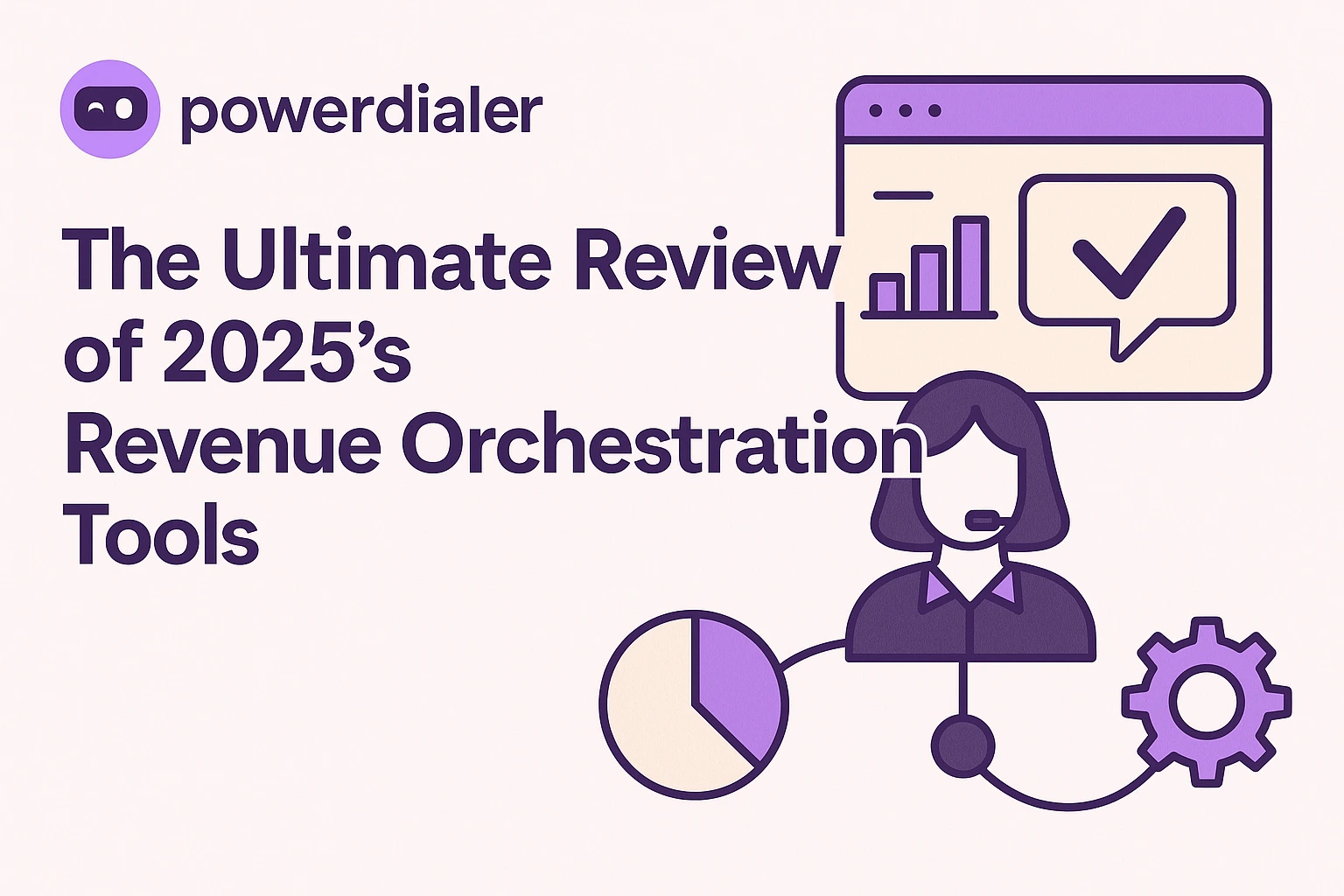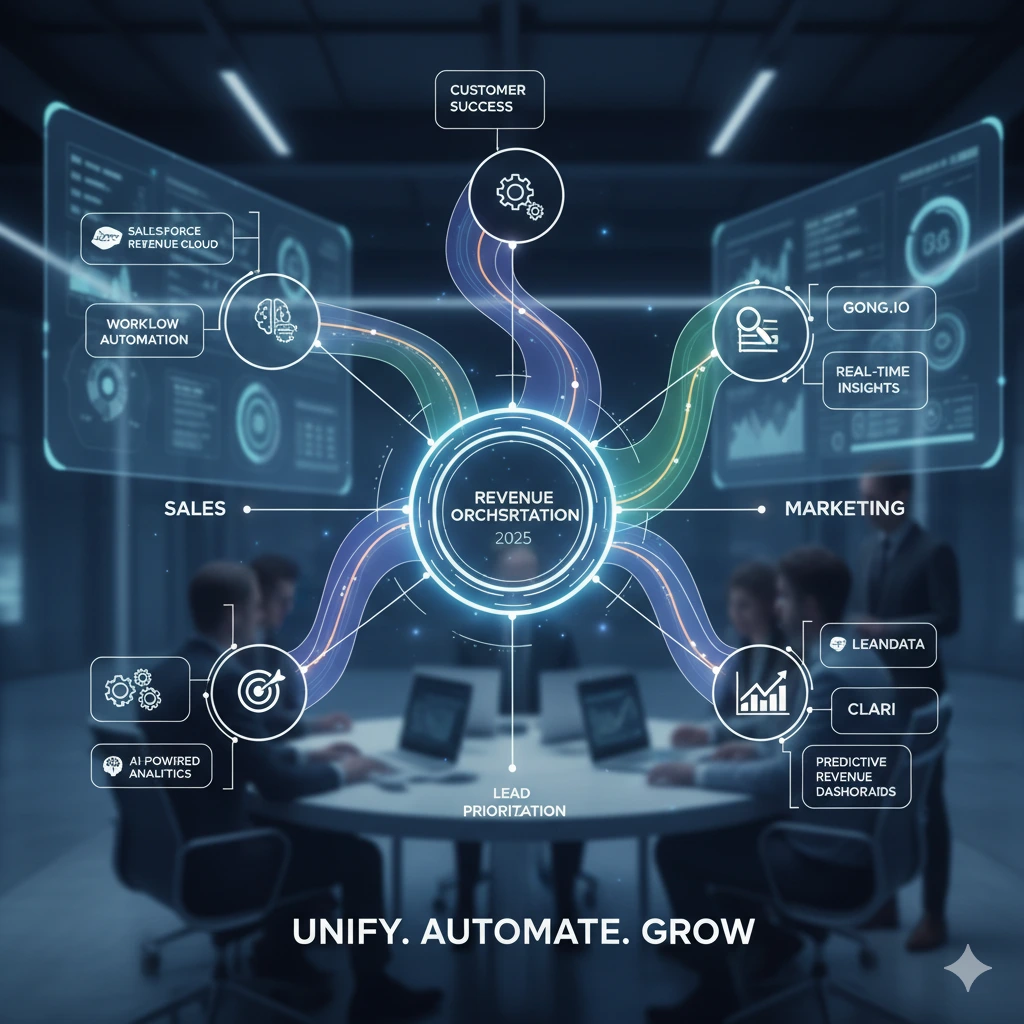
The Ultimate Review of 2025’s Revenue Orchestration Tools
Summary:
Revenue orchestration tools are transforming the way businesses manage sales, marketing, and customer success operations. In 2025, these platforms have become essential for companies aiming to align teams, automate workflows, and gain real-time insights into revenue performance. By integrating sales automation, marketing automation, and revenue analytics, these tools help organizations improve forecasting accuracy, prioritize leads effectively, and make data-driven decisions that drive growth.
The best revenue orchestration platforms of 2025 not only streamline complex processes but also enhance collaboration between departments. Solutions like Salesforce Revenue Cloud, Gong.io, Clari, and LeanData provide features such as AI-powered analytics, workflow automation, and predictive revenue dashboards. With these platforms, businesses can optimize revenue operations, increase efficiency, and improve customer experiences, making them a critical investment for organizations looking to scale in today’s competitive market.

Revenue orchestration technology is transforming the way companies interact with revenue operations. These tools are a necessity in 2025 to harmonize sales, marketing, and customer success efforts and streamline processes and increase the accuracy of forecasting. Companies utilizing these solutions aren't just streamlining operations, they're fueling revenue with intelligent metrics.
For any business that holds profit maximization and process optimization at the top of its agenda, revenue orchestration software is no longer an option. This review contrasts the top revenue orchestration software 2025 has to offer, ranks must-have features, advantages, and real-case scenarios, and gives blunt advice on how to select the best software.
Why Revenue Orchestration Matters in 2025

What Is Revenue Orchestration
Revenue orchestration software has one platform for all the revenue functions like sales automation, marketing automation, and customer success. Orchestration makes department alignment seamless, and they're all working towards shared revenue goals.
Breaking Sales, Marketing, and Customer Success Silos: Orchestration breaks silos and ensures marketing provides qualified leads, sales convert them successfully, and customer success retains them.
Revenue Growth Automations Workflows: Lead follow-ups, appointment setting, and nurturing campaigns are automated and enable teams to focus on strategic efforts.
Benefits for Modern Businesses: Organizations gain better visibility on revenue performance, minimize human errors, and expand the sales cycle.
Revenue orchestration software also enables revenue operations, enabling organizations to connect departmental metrics, gain pipeline visibility, and enable data-driven decisions. Synchronization with analytics for sales forecasting and revenue software provides teams with the data equivalent of bottom-line traction.
Top Trends which are Shaping Revenue Orchestration in 2025
Revenue orchestration is evolving at a breakneck pace, and keeping up with trends is most critical.
- AI-Based Sales Forecasting: AI-driven algorithms are leveraged by existing technology for revenue forecasting, high-value lead qualification, and recommending next sales action.
- Revenue Dashboards: Dashboards aggregate data from numerous sources to present the whole revenue performance landscape.
- Data-Driven Decisioning: Real-time analytics yield decision control, campaign optimization, and lead management software maximization.
- Integrated Marketing and Sales Platforms: Next-generation orchestration platforms integrate marketing automation and CRM for seamless data exchange and better alignment.
- Customer Experience Orientation: The latest technology captures the full customer experience to allow businesses to gain full satisfaction and retention through aggregated interaction.
Informed by these trends, business firms will remain competitive and gain optimal revenue efficiency in 2025 and beyond.
Best Revenue Orchestration Platforms of 2025
The choice of best revenue orchestration platforms is the secret to gaining maximum ROI. Following is a comprehensive review of highly rated platforms.
1. Salesforce Revenue Cloud
Salesforce Revenue Cloud is an end-to-end platform for revenue orchestration that can be applied in large organizations. The platform integrates AI-driven analytics, CRM, and revenue dashboards to help organizations manage opportunities, automate processes, and forecast revenue. Salesforce Revenue Cloud allows sales, finance, and operations teams to get their processes in sync and make informed decisions.
Integrations:
- Salesforce Revenue Cloud supports integration with almost any CRM
- Marketing automation platform, and third-party application
- Enabling end-to-end data synchronization throughout the entire revenue system.
Ease of Use: Medium
While feature-rich, it will take new admins some time to get to use its more sophisticated functions. Its whole feature repertoire makes it perfect for companies with complex revenue operations.
2. Gong.io
Gong.io is a sales and marketing alignment specialist through conversation analytics and automated workflow. Gong.io captures sales conversations, translates customers' conversation, and offers actionable insights for improving coaching, improving conversion rates, and facilitating follow-ups. Automated flows assist in engaging leads at the right moment, improving overall efficiency.
Integration:
Gong.io is integrated with top CRMs and marketing solutions to provide smooth integration of sales and marketing data and maximize operations.
Ease of Use: Easy.
The product is straightforward to use, offering actionable advice that can be used immediately by sales teams without any rigid setup, enabling immediate and effortless adoption.
3. Clari
Clari is a pipeline management and revenue planning software that provides real-time predictive sales team insights and dashboards as well as predictive revenue. It helps in monitoring opportunities, measuring team performance, as well as identifying potential revenue risk. With its AI-driven insights, teams can make smart strategic decisions, automate sales cycles, and achieve predictability in revenue.
Integrations: High.
Clari integrates CRM platforms, ERP platforms, and marketing automation platforms to create an integrated and holistic view of revenue operations.
Ease of Use: Medium.
Although analytics are complicated, small-sized teams can be initially aided with a meaningful interpretation of the data. It is especially for those companies that want to have precise forecasting.
4. LeanData
LeanData is sales function automation and lead management technology designed to automate sales functions. LeanData streamlines lead routing, sends leads to the correct sales reps, and traces the customer journey to drive the most conversions. LeanData removes delays, optimizes team productivity, and powers revenue operations by simplifying complex processes.
Integrations: Medium.
LeanData integrates best-of-breed CRMs and marketing automation platforms to allow alignment between the sales and marketing teams.
Ease of Use: Easy.
Its simple interface and focus on automation make it easy for mid-sized teams to use with the requirement for automation of revenue activities and lead administration with little learning curve.
Quick Comparison Table of Top Platforms
Key Features to Look for in Revenue Orchestration Tools
Most important features are carefully considered in choosing the best tool.
AI-Powered Forecasting and Analytics
Sales organizations are authorized to prioritize deals based on AI-driven insights. Historical sales activity, revenue, and pipeline data are reviewed by machine processes and utilized in providing accurate forecast estimates and eliminating decision uncertainty.
Automated Task and Workflow Management
With the automated reminder, follow-up, and reporting process, the error is removed and there is efficiency, and no lead gets lost during the process. Optimization and automation teams for sales workflow must be recruited.
Lead Scoring and Prioritization
Not all leads are similar to one another. Lead management software aids in prioritizing prospects on willingness to buy, engagement, and behavior so that your salespeople can prioritize high-priority opportunities.
Integration with CRM and Marketing Applications
Smooth integration of marketing automation and CRM systems provides end-to-end visibility to customer interactions, resulting in better alignment of sales and marketing teams.
Revenue Performance Dashboards
Intuitive dashboards are able to monitor conversion percentages, revenue KPIs, and pipeline health. Such information helps leaders make effective and timely strategic decisions.
Benefits of Using Revenue Orchestration Tools
- Enhanced Revenue Effectiveness: Orchestration and automation accelerate revenue cycles.
- Improved Sales and Marketing Alignment: Teams transcend shared data, with better messaging and greater coordination.
- Better Forecasting and Decision-Making: Real-time customer and sales forecasting enables wiser decisions.
- Fewer Manual Workarounds: Automated workflows enable teams to perform at a higher level of activity.
- Better Customer Experience: Coordinated engagement fosters satisfaction and loyalty.
Firms that utilize PowerDialer.ai have seen monumental productivity gains due to automated follow-ups, calls, and meetings. Schedule a demo and observe how it will revolutionize your sales process.
How to Pick the Ideal Revenue Orchestration Platform
- Evaluate Your Existing Revenue Operations: Process gaps, reporting, and team alignment.
- Identify Must-Have Features: Search for AI analytics, automation, dashboards, and CRM integration.
- Consider Scalability and Integrations: Select a platform that grows with your company and integrates with your equipment.
- Review Pricing vs ROI: Select tools that are proven to bring measurable revenue efficiency gains.
- Test Platforms with Free Trials or Demos: In-the-wild testing is the best test of usability and adoption.
Case Studies: Success Stories in Revenue Orchestration
Revenue orchestration translates to tangible results in every industry.
Company A: Facilitated 35% more leads to be converted to sales through automated workflows and sales automation functionality.
Company B: Achieved 25% higher forecasting accuracy by leveraging predictive analytics dashboards.
Company C: Automated 40% of mundane tasks, enabling the sales teams to focus on high-leverage activities.
Case study metrics measure the effectiveness of revenue performance tools to business growth and ROI.
Shared Challenges & Avoiding Them
Integration Challenges: Select platforms with robust APIs and integrations already established.
Change Management: Spend in training classes and offer support for smooth adoption.
Data Quality Issues: Provide clean, normalized data to deliver good-quality analytics.
User Adoption: Create friendly interfaces and make it easy to drive team adoption.
Conclusion
Revenue orchestration technology is no longer a nicety, but a necessity, for companies who want to tap into the power of revenue operations in 2025. They make possible the automation, unite the teams, enable better forecasting, and provide richer customer experiences. Function, scalability, and ROI being the priorities, companies are presented with the best tool for attaining measurable growth. Solutions such as PowerDialer.ai have enhanced the capabilities of automation, analytical, and integration components to make it simpler to achieve revenue goals. Request a demo and compare for yourself. Experience a demo of PowerDialer.ai and discover how your business can dial, follow up, and close on auto-pilot.
FAQs
Q1: What is a revenue orchestration platform?
A1: It is technology that coordinates sales, marketing, and customer success activity to generate extra revenue.
Q2: How does revenue orchestration differ from CRM software?
A2: CRMs store customer data, while solutions in revenue orchestration facilitate automation, insights, and support team alignment for revenue functions.
Q3: Are the tools applicable for small businesses?
A3: Yes. The platforms are all relatively cheap and scalable, while small businesses can automate operations and make more money.
Q4: Are the solutions integrated into existing marketing automation platforms?
A4: Yes. The majority of the solutions natively integrate with marketing automation tools and CRMs.
Q5: What benefits do revenue orchestration solutions have on forecasting accuracy?
A5: Through predictive analytics and sales forecasting software, such programs use past history to make actual revenue projections.
